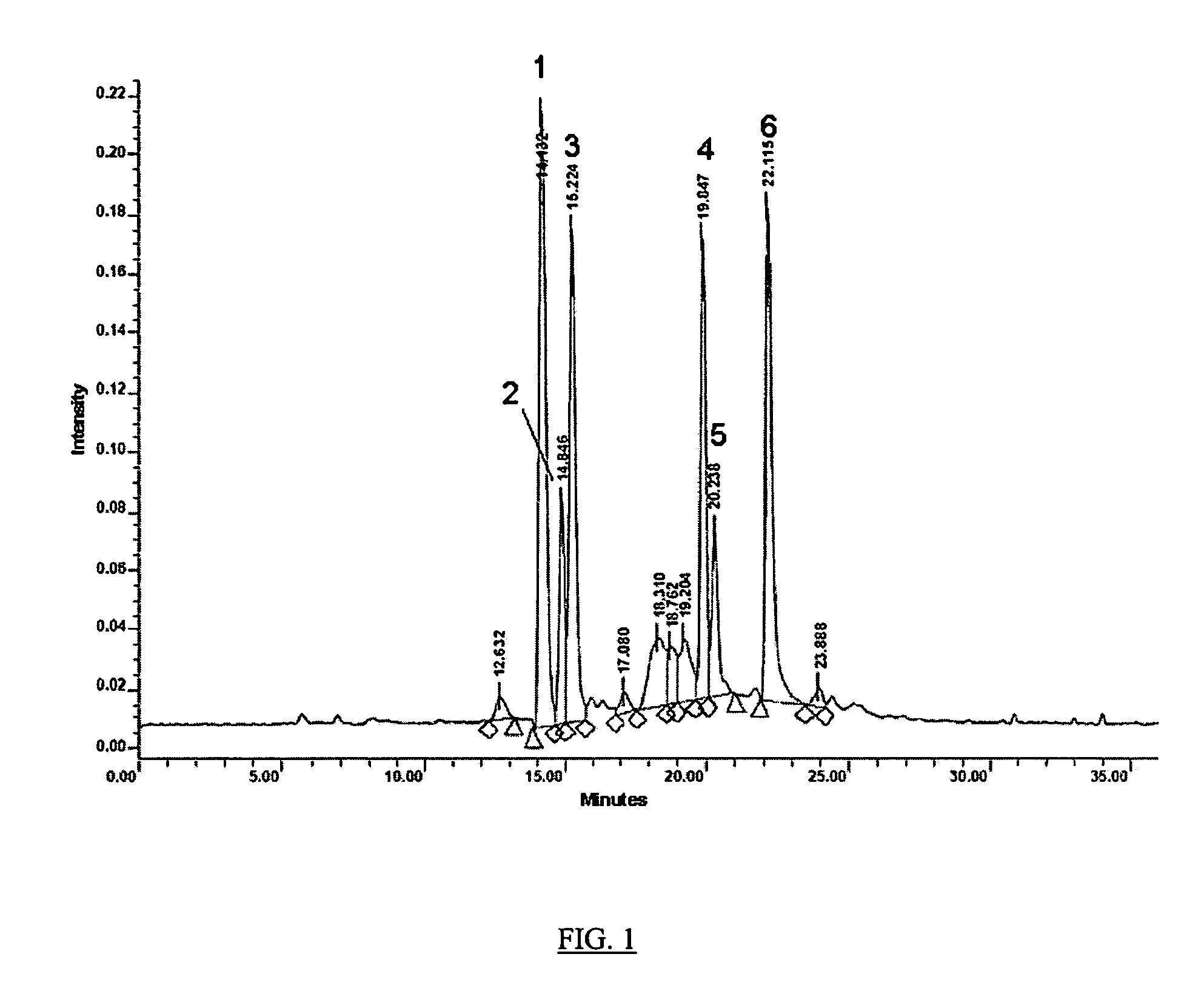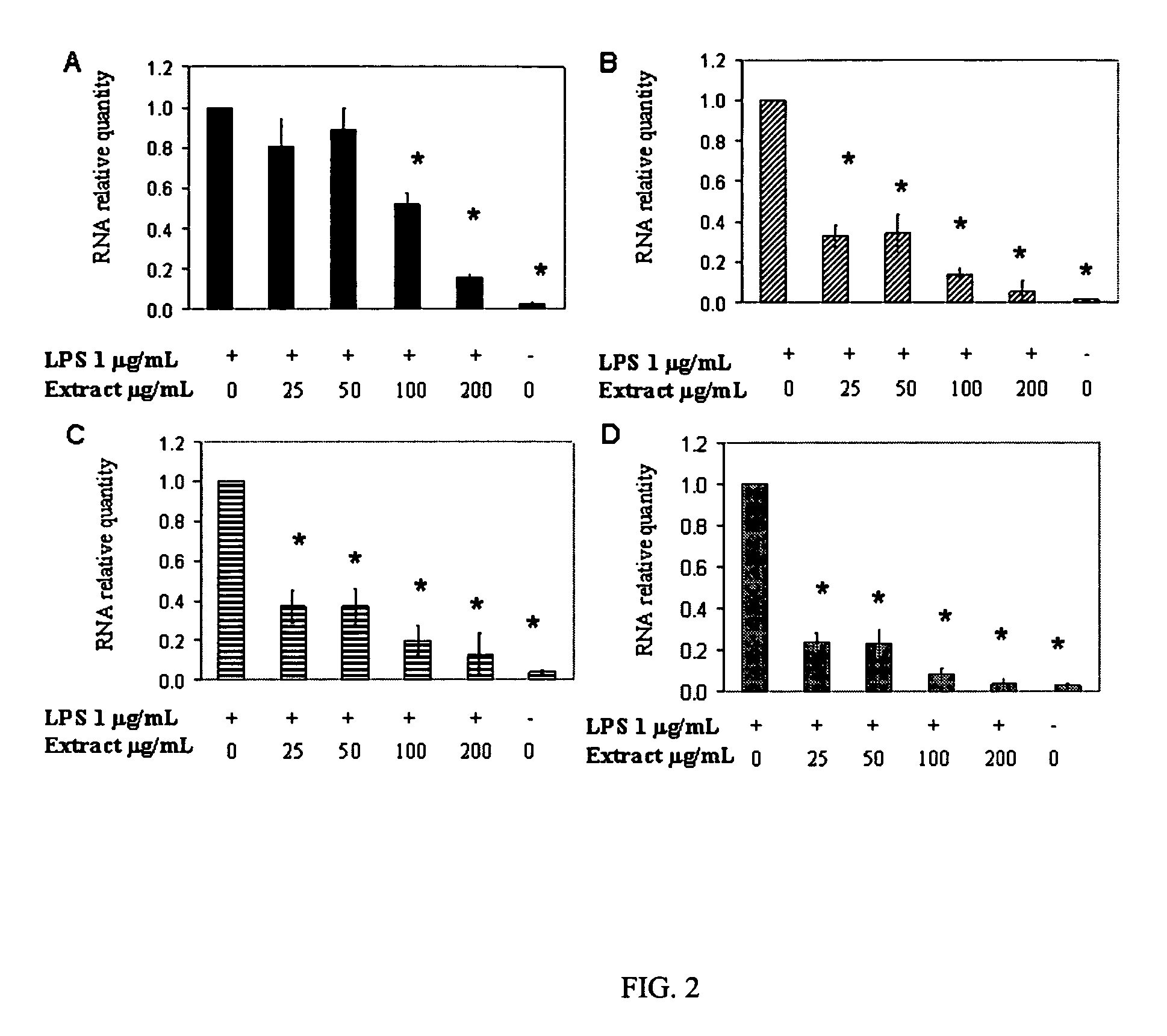In vitro and in vivo anti-inflammatory effects of a sesquiterpene lactone extract from chicory (Cichorium intybus L.)
a technology of sesquiterpene lactone and chicory, which is applied in the field of extracting sesquiterpene lactone from chicory, can solve the problems of significant negative side effects and reduce the use of certain segments of the population, and achieve the effect of reducing inflammation
- Summary
- Abstract
- Description
- Claims
- Application Information
AI Technical Summary
Benefits of technology
Problems solved by technology
Method used
Image
Examples
example 1
Extraction Procedure
[0027]Chicory cv. Sacson roots were commercially obtained. The sesquiterpene-enriched extract of the present invention was prepared by the following procedure. Dry, milled chicory roots (1 kg) were extracted in 10 L of 95% ethanol for 24 hours at room temperature (24° C.). The resulting ethanolic extract was defatted with n-heptane. A secondary extraction of the defatted ethanolic extract with ethyl acetate created an extract containing at least 60% sesquiterpene lactones as determined by LC-MS. Solvents were removed under vacuum, creating a brown syrup that was stored at 4° C.
example 2
LC-MS Analysis
[0028]Chicory extract was separated and analyzed with the Waters (Milford, Mass.) LC-MS Integrity™ system consisting of a solvent delivery system including a W616 pump and W600S controller, W717 plus auto-sampler, W996 PDA detector and Waters TMD Thermabeam™ electron impact (EI) single quadruple mass detector. Data were collected and analyzed with the Waters Millennium® v. 3.2 software, linked with the 6th edition of the Wiley Registry of Mass Spectral Data, containing 229,119 EI spectra of 200,500 compounds. Substances were separated on a Phenomenex® Luna C-8 reverse phase column, size 150×2 mm, particle size 3 μm, pore size 100 Å, equipped with a Phenomenex® SecurityGuard™ pre-column. The mobile phase consisted of 2 components: Solvent A (0.5% ACS grade acetic acid in double distilled de-ionized water, pH 3-3.5), and Solvent B (100% Acetonitrile). The mobile phase flow was adjusted at 0.25 ml / min, and generally a gradient mode was used for all analyses. The gradient ...
example 3
Cell Culture
[0031]RAW 264.7 murine monocyte / macrophages (ATCC TIB-71) were maintained in Dulbecco's Modified Eagle Medium (D-MEM) supplemented with 10% fetal bovine serum (FBS) and 1% streptomycin and were kept in a humidified 37° C. incubator with 5% CO2. Cells were subcultured by scraping when plates reached 90% confluency with a 1:5 ratio.
Quantitative Real-Time RT-PCR
[0032]Murine RAW macrophages 264.7 were plated in 24-well plates 12 hours prior to treatment. The cells were treated with extracts of various concentrations for 2 hours before elicitation with lipopolysaccharide (LPS) at 1 μg / ml. After 6 hours of treatment, RNA was extracted from cells using TRIzol® reagent (Invitrogen, Carlsbad, Calif.) according to the manufacturer instructions. RNAs were quantified spectrophotometrically at 260 nm and stored at −80° C. until real-time PCR could be performed.
[0033]RNA was treated with Dnase RQ1 (Promega, Madision, Wis.) before performing reverse transcription with superscript II H-...
PUM
| Property | Measurement | Unit |
|---|---|---|
| temperature | aaaaa | aaaaa |
| particle size | aaaaa | aaaaa |
| size | aaaaa | aaaaa |
Abstract
Description
Claims
Application Information
 Login to View More
Login to View More - R&D
- Intellectual Property
- Life Sciences
- Materials
- Tech Scout
- Unparalleled Data Quality
- Higher Quality Content
- 60% Fewer Hallucinations
Browse by: Latest US Patents, China's latest patents, Technical Efficacy Thesaurus, Application Domain, Technology Topic, Popular Technical Reports.
© 2025 PatSnap. All rights reserved.Legal|Privacy policy|Modern Slavery Act Transparency Statement|Sitemap|About US| Contact US: help@patsnap.com


